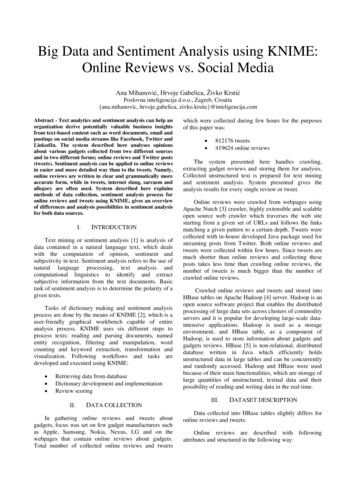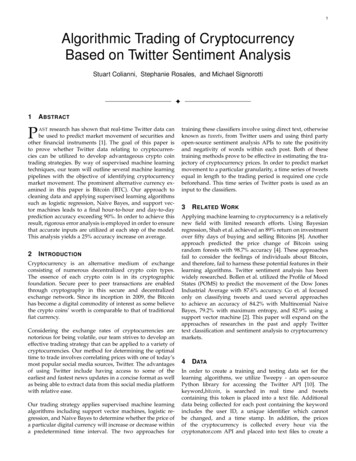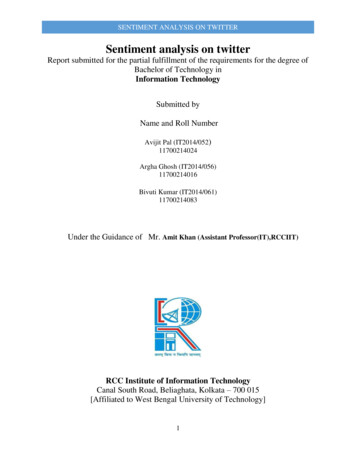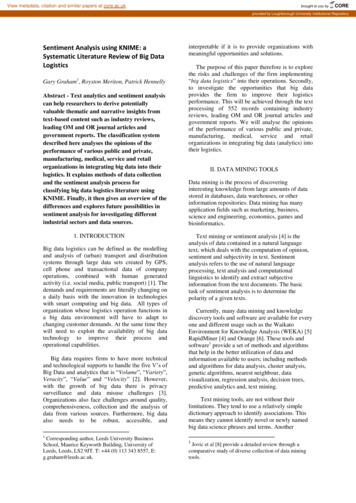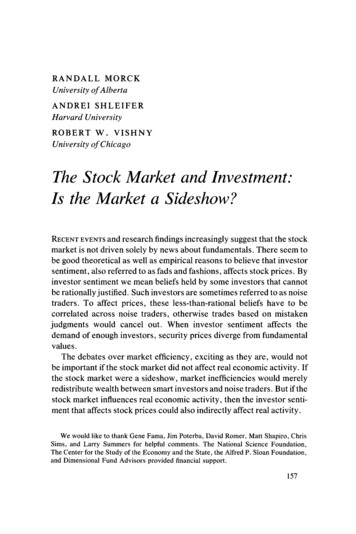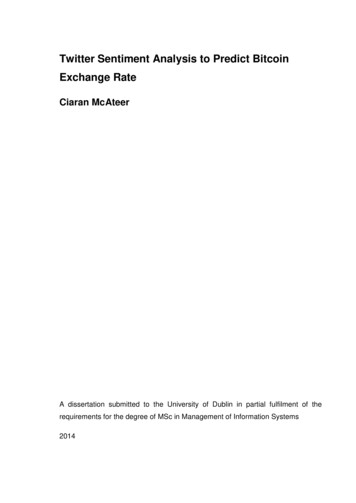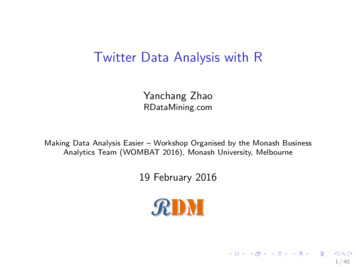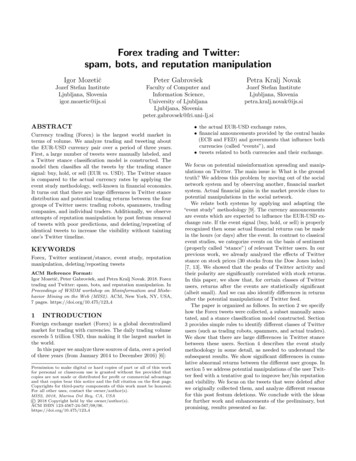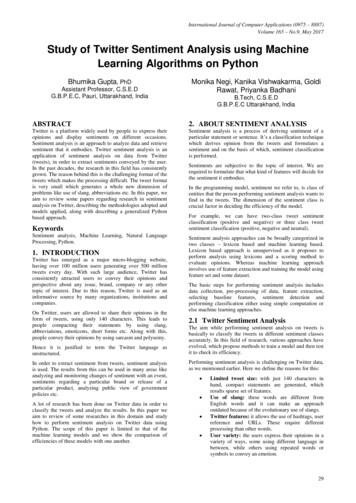
Transcription
International Journal of Computer Applications (0975 – 8887)Volume 165 – No.9, May 2017Study of Twitter Sentiment Analysis using MachineLearning Algorithms on PythonBhumika Gupta, PhDAssistant Professor, C.S.E.DG.B.P.E.C, Pauri, Uttarakhand, IndiaMonika Negi, Kanika Vishwakarma, GoldiRawat, Priyanka BadhaniB.Tech, C.S.E.DG.B.P.E.C Uttarakhand, IndiaABSTRACT2. ABOUT SENTIMENT ANALYSISTwitter is a platform widely used by people to express theiropinions and display sentiments on different occasions.Sentiment analysis is an approach to analyze data and retrievesentiment that it embodies. Twitter sentiment analysis is anapplication of sentiment analysis on data from Twitter(tweets), in order to extract sentiments conveyed by the user.In the past decades, the research in this field has consistentlygrown. The reason behind this is the challenging format of thetweets which makes the processing difficult. The tweet formatis very small which generates a whole new dimension ofproblems like use of slang, abbreviations etc. In this paper, weaim to review some papers regarding research in sentimentanalysis on Twitter, describing the methodologies adopted andmodels applied, along with describing a generalized Pythonbased approach.Sentiment analysis is a process of deriving sentiment of aparticular statement or sentence. It’s a classification techniquewhich derives opinion from the tweets and formulates asentiment and on the basis of which, sentiment classificationis performed.KeywordsSentiment analysis, Machine Learning, Natural LanguageProcessing, Python.1. INTRODUCTIONTwitter has emerged as a major micro-blogging website,having over 100 million users generating over 500 milliontweets every day. With such large audience, Twitter hasconsistently attracted users to convey their opinions andperspective about any issue, brand, company or any othertopic of interest. Due to this reason, Twitter is used as aninformative source by many organizations, institutions andcompanies.On Twitter, users are allowed to share their opinions in theform of tweets, using only 140 characters. This leads topeople compacting their statements by using slang,abbreviations, emoticons, short forms etc. Along with this,people convey their opinions by using sarcasm and polysemy.Hence it is justified to term the Twitter language asunstructured.In order to extract sentiment from tweets, sentiment analysisis used. The results from this can be used in many areas likeanalyzing and monitoring changes of sentiment with an event,sentiments regarding a particular brand or release of aparticular product, analyzing public view of governmentpolicies etc.A lot of research has been done on Twitter data in order toclassify the tweets and analyze the results. In this paper weaim to review of some researches in this domain and studyhow to perform sentiment analysis on Twitter data usingPython. The scope of this paper is limited to that of themachine learning models and we show the comparison ofefficiencies of these models with one another.Sentiments are subjective to the topic of interest. We arerequired to formulate that what kind of features will decide forthe sentiment it embodies.In the programming model, sentiment we refer to, is class ofentities that the person performing sentiment analysis wants tofind in the tweets. The dimension of the sentiment class iscrucial factor in deciding the efficiency of the model.For example, we can have two-class tweet sentimentclassification (positive and negative) or three class tweetsentiment classification (positive, negative and neutral).Sentiment analysis approaches can be broadly categorized intwo classes – lexicon based and machine learning based.Lexicon based approach is unsupervised as it proposes toperform analysis using lexicons and a scoring method toevaluate opinions. Whereas machine learning approachinvolves use of feature extraction and training the model usingfeature set and some dataset.The basic steps for performing sentiment analysis includesdata collection, pre-processing of data, feature extraction,selecting baseline features, sentiment detection andperforming classification either using simple computation orelse machine learning approaches.2.1 Twitter Sentiment AnalysisThe aim while performing sentiment analysis on tweets isbasically to classify the tweets in different sentiment classesaccurately. In this field of research, various approaches haveevolved, which propose methods to train a model and then testit to check its efficiency.Performing sentiment analysis is challenging on Twitter data,as we mentioned earlier. Here we define the reasons for this: Limited tweet size: with just 140 characters inhand, compact statements are generated, whichresults sparse set of features.Use of slang: these words are different fromEnglish words and it can make an approachoutdated because of the evolutionary use of slangs.Twitter features: it allows the use of hashtags, userreference and URLs. These require differentprocessing than other words.User variety: the users express their opinions in avariety of ways, some using different language inbetween, while others using repeated words orsymbols to convey an emotion.29
International Journal of Computer Applications (0975 – 8887)Volume 165 – No.9, May 2017All these problems are required to be faced in the preprocessing section.Apart from these, we face problems in feature extraction withless features in hand and reducing the dimensionality offeatures. Stemming: Replacing words with their roots, reducingdifferent types of words with similar meanings [3].This helps in reducing the dimensionality of the featureset. Special character and digit removal: Digits andspecial characters don’t convey any sentiment.Sometimes they are mixed with words, hence theirremoval can help in associating two words that wereotherwise considered different. Creating a dictionary to remove unwanted wordsand punctuation marks from the text [5]. Expansion of slangs and abbreviations [5]. Spelling correction [5]. Generating a dictionary for words that areimportant [7] or for emoticons [2]. Part of speech (POS) tagging: It assigns tag to eachword in text and classifies a word to a specificcategory like noun, verb, adjective etc. POS taggersare efficient for explicit feature extraction.3. METHODOLOGYIn order to perform sentiment analysis, we are required tocollect data from the desired source (here Twitter). This dataundergoes various steps of pre-processing which makes itmore machine sensible than its previous form.3.3 Feature ExtractionFig. 1 – General Methodology for sentiment analysis3.1 Tweet CollectionTweet collection involves gathering relevant tweets about theparticular area of interest. The tweets are collected usingTwitter’s streaming API [1], [3], or any other mining tool (forexample WEKA [2]), for the desired time period of analysis.The format of the retrieved text is converted as perconvenience (for example JSON in case of [3], [5]).The dataset collected is imperative for the efficiency of themodel. The division of dataset into training and testing sets isalso a deciding factor for the efficiency of the model. Thetraining set is the main aspect upon which the results depends.3.2 Pre-processing of tweetsThe preprocessing of the data is a very important step as itdecides the efficiency of the other steps down in line. Itinvolves syntactical correction of the tweets as desired. Thesteps involved should aim for making the data more machinereadable in order to reduce ambiguity in feature extraction.Below are a few steps used for pre-processing of tweets Removal of re-tweets. Converting upper case to lower case: In case we areusing case sensitive analysis, we might take twooccurrence of same words as different due to theirsentence case. It important for an effective analysis notto provide such misgivings to the model. Stop word removal: Stop words that don’t affect themeaning of the tweet are removed (for example and,or, still etc.). [3] uses WEKA machine learningpackage for this purpose, which checks each wordfrom the text against a dictionary ([3], [5]).Twitter feature removal: User names and URLs arenot important from the perspective of futureprocessing, hence their presence is futile. Allusernames and URLs are converted to generic tags [3]or removed [5].A feature is a piece of information that can be used as acharacteristic which can assist in solving a problem (likeprediction [11]). The quality and quantity of features is veryimportant as they are important for the results generated bythe selected model.Selection of useful words from tweets is feature extraction. Unigram features – one word is considered at atime and decided whether it is capable of being afeature.N-gram features – more than one word isconsidered at a time.External lexicon – use of list of words withpredefined positive or negative sentiment.Frequency analysis is a method to collect features withhighest frequencies used in [1]. Further, they removed someof them due to the presence of words with similar sentiment(for example happy, joy, ecstatic etc.) and created a group ofthese words. Along with this affinity analysis is performed,which focuses on higher order n-grams in tweet featurerepresentation.Barnaghi et al [3], use unigrams and bigrams and apply TermFrequency Inverse Document Frequency (TF-IDF) to find theweight of a particular feature in a text and hence filter thefeatures having the maximum weight. The TF-IDF is a veryefficient approach and is widely used in text classification anddata mining.Bouazizi et al [4], propose an approach were they don’t justrely on vocabulary used but also the expressions and sentencestructure used in different conditions. They classified featuresinto four classes: sentiment based features, punctuation andsyntax based features, unigram based features and patternbased features.The work of [5] is a bit different as they don’t focus on aparticular topic or event but propose to find trending topics ina region. The features extracted are divided in two categories:Common Features and Tweet Specific Features. The former iscombination of common sentiment words while the laterincludes @-network features, user sentiment features andemoticons. Based on the post time of each user, feature vectoris built.30
International Journal of Computer Applications (0975 – 8887)Volume 165 – No.9, May 2017of knowledge and learning takes place at each leveland forwarded to the next level. The hidden layersare dynamically generated until a desired level ofperformance is achieved.3.4 Sentiment classifiers Bayesian logistic regression: selects features andprovides optimization for performing textcategorization. It uses a Laplace prior to avoid overfitting and produces sparse predictive models fortext data. The Logistic Regression estimationhas the parametric form:Wherea normalization function, λ is is a vectorof weight parameters for feature set andis abinary function that takes as input a feature and aclass label. It is triggered when a certain featureexists and the sentiment is hypothesized in a certainway [3]. . Maximum Entropy Classifier: This classifiertakes no assumptions regarding the relationsbetween features; it always tries to maximizeentropy of a system by computing its conditionaldistribution of its class labels [9].’X’ is the feature vector and ’y’ is the class label.Z(X) is the normalization factor and is the weightcoefficientwhich is the feature functionwhich is defined as}Naïve Bayes is a very simple classifier withacceptable results but not as good as otherclassifiers.Support Vector Machine Algorithm: Supportvector machines are supervised models withassociated learning algorithms that analyze dataused for classification and regression analysis [6],[9]. It makes use of the concept of decision planesthat define decision boundaries.X is feature vector, ‘w’ is weights of vector and ‘b’is bias vector.is the non-linear mapping frominput space to high dimensional feature space.SVMs can be used for pattern recognition [2]. Case Base Reasoning: In this technique, problemsthat were successfully solved in the past areaccessed and their solutions are retrieved and usedfurther [10]. It doesn’t require an explicit domainmodel, making elicitation a task of gathering casehistories and CBR system can acquire newknowledge as cases. This makes maintenance oflarge columns of information easier.Naïve Bayes: It is a probabilistic classifier withstrong conditional independence assumption that isoptimal for classifying classes with highlydependent features. Adherence to the sentimentclasses is calculated using the Bayes theorem.X is a feature vector defined as X { ,and is a class label. Ensemble classifier: This classifier try to make useof features of all the base classifiers to do the bestclassification. Base classifier used by [9] wereNaïve Bayes, SVM and Maximum Entropy. Theclassifier classifies based on the output of majorityof classifiers (voting rule).4. TWITTER SENTIMENT ANALYSISWITH PYTHON4.1 PythonPython is a high level, interpreted programming language,created by Guido van Rossum. The language is very popularfor its code readability and compact line of codes. It uses whitespace inundation to delimit blocks.Artificial Neural Network: the ANN model usedfor supervised learning is the Multi-LayerPerceptron, which is a feed forward model thatmaps data onto a set of pertinent outputs. Trainingdata given to input layer is processed by hiddenintermediate layers and the data goes to the outputlayers. The number of hidden layers is veryimportant metric for the performance of the model.There are two steps of working of MLP NN- feedforward propagation, involving learning featuresfrom feed forward propagation algorithm and backpropagation, for cost function [5], [10].Python provides a large standard library which can be used forvarious applications for example natural language processing,machine learning, data analysis etc.Zimbra et al [1] propose an approach to useDynamic Architecture for Artificial Neural Network(DAN2) which is a machine learned model withsufficient sensitivity to mild expression in tweets.They target to analyze brand related sentimentswhere occurrences of mild sentences are frequent.The NLTK library also embodies various trainable classifiers(example – Naïve Bayes Classifier).DAN2 is different than the simple neural networksas the number of hidden layers is not fixed beforeusing the model. As the input is given, accumulationIt is favored for complex projects, because of its simplicity,diverse range of features and its dynamic nature.4.2 Natural Language Processing (NLTK)Natural Language toolkit (NLTK) is a library in python,which provides the base for text processing and classification.Operations such as tokenization, tagging, filtering, textmanipulation can be performed with the use of NLTK.NLTK library is used for creating a bag-of words model,which is a type of unigram model for text. In this model, thenumber of occurrences of each word is counted. The dataacquired can be used for training classifier models. Thesentiment of the entire tweets is computed by assigningsubjectivity score to each word using a sentiment lexicon.31
International Journal of Computer Applications (0975 – 8887)Volume 165 – No.9, May 20174.3 SCIKIT-LEARN Open the ‘Keys and Access Tokens’ tab.The Scikit-learn project started as scikits.learn, a GoogleSummer Code project by David Cournapeau. It is a powerfullibrary that provides many machine learning classificationalgorithms, efficient tools for data mining and data analysis.Below are various functions that can be performed using thislibrary: Copy ‘Consumer Key’, ‘Consumer Secret’, ‘Accesstoken’ and ‘Access Token Secret’. Classification: Identifying the category to which aparticular object belongs.Regression: Predicting a continuous-valuedattribute associated with an object.Clustering: Automatic grouping of similar objectsinto sets.Dimension Reduction: Reducing the number ofrandom variables under consideration.Model selection: Comparing, validating andchoosing parameters and tion in order to transform input data foruse with machine learning algorithm.In order to work with scikit-learn, we are required to installNumPy on the system.4.4 NumPyNumPy is the fundamental package for scientific computingwith Python. It provides a high-performance multidimensionalarray object, and tools for working with these arrays. Itcontains among other things: A powerful N-dimensional array objectSophisticated (broadcasting) functionsTools for integrating C/C and Fortran codeUseful linear algebra, Fourier transform, andrandom number capabilities.4.5 Setting Up Environment for SentimentAnalysis Using PythonThe following components are required to be downloaded andinstalled properly. Download and install Python 2.6 or above in adesired location. Download and install NumPy. Download and install NLTK library. Download and install Scikit-learn library.4.6 Data CollectionWe have two options to collect data for sentiment analysis.First is to use Tweepy - client for Twitter ApplicationProgramming Interface (API).It can be installed using pip command: pip install tweepyTo fetch tweets from the Twitter API one needs to register anApp through their Twitter account. After that the followingsteps are performed: Open https://apps.twitter.com/ and click button –‘Create New App’. Fill the details asked. When the App is created, the page will beautomatically loaded.The keys copied are then inserted into the code, which helpsin dynamic collection of tweets every time we run it.The other option is to gather data non-dynamically using theexisting data provided by websites (like kaggle.com) and savethe data into whatever format we require (for example JSON,csv etc.).The former method is slow in nature as it performs tweetcollection every time we start the program. The latterapproach may not provide us with the quality of tweets werequire.To solve this we can put the code for tweet collection indifferent module in a way that it doesn’t operate every timewe run the project.4.7 Pre-processing in PythonThe pre-processing in Python is easy to perform due tofunctions provided by the standard library. Some of the stepsare given below: Converting all upper case letters to lower case.Removing URLs: Filtering of URLs can be donewiththehelpofregularexpression(http https ftp)://[a-zA-Z0-9\\./] .Removing Handles (User Reference): Handles canbe removed using regular expression - @(\w ) .Removing hashtags: Hashtags can be removedusing regular expression - #(\w ).Removing emoticons: We can use emoticondictionary to filter out the emoticons or to save theoccurrence of them in a different file.Removing repeated characters.4.8 Feature ExtractionVarious methodologies for extracting features are available inthe present day. Term frequency-Inverse Document frequencyis an efficient approach. TF-IDF is a numerical statistic thatreflects the value of a word for the whole document (here,tweet).Scikit-learn provides vectorizers that translate inputdocuments into vectors of features. We can use libraryfunction TfidfVectorizer(), using which we can provideparameters for the kind of features we want to keep bymentioning the minimum frequency of acceptable features.4.9 TRAINING A MODELThe scikit-library provides various machine learning modelswhose implementation in code is very easy. For example onecan easily create an instance of Support Vector Machine inone line –classifier poly svm.SVC()In order to make use of machine learning models, one isrequired to remember to install NumPy properly and importfrom scikit-learn the desired model.After training the model we, use the same instance to test themodel and save the results obtained.32
International Journal of Computer Applications (0975 – 8887)Volume 165 – No.9, May 20175. EXPERIMENTATION FOR MODELVALIDATIONAfter the pre-processing and feature extraction steps areperformed, we work towards training and validating themodel’s performance. The collected dataset is divided in two–training set and testing set. The training set is used to train theclassifier (machine learned model) while the testing set is theone on which the experimentation is performed. The ratio oftraining and testing dataset can vary as per to applications. [1]divides the dataset as 70% training and rest testing, whereas[3] which uses cross validation on the dataset by splitting itinto 10 sections. This method selects 90% for training set and10 for testing.[4] divided the set as training set containing 21000 tweetswhile testing set 1400 tweets (approx. 93% and 7%) while [5]used 75% data for training set and [9] used approx. 83% fortraining.As the classification work in [6] is topic based and adaptive innature hence excessive manual labeling is avoided whichreduces the size of training set.Table 1: Average accuracies of different %3.Bayesian Logistic Regression74.84%4.Naïve Bayes66.24%5.Random Forest Classifier87.5%6.Neural Network89.93%7.Maximum Entropy90.0%8.Ensemble classifier90.0%5.1 Applications As the classification work in [6] is topic based and adaptive innature hence excessive manual labeling is avoided whichreduces the size of training set.Commerce: Companies can make use of thisresearch for gathering public opinion related to theirbrand and products. From the company’sperspective the survey of target audience isimperative for making out the ratings of theirproducts. Hence Twitter can serve as a goodplatform for data collection and analysis todetermine customer satisfaction. The proposed work of [3] is a bit different as they correlatethe event and sentiment by using timestamp. Using thismethod for a particular event, it’s possible to divide it intosub-events and further deepen the study of user sentiments.This approach is complex but yield very detail results whenwe chose a large event and desire to see fluctuations in usersentiments with time.Politics: Majority of tweets on Twitter are related topolitics. Due to Twitter’s widespread use, manypoliticians are also aiming to connect to peoplethrough it. People post their support or disagreementtowards government policies, actions, elections,debates etc. Hence analyzing data from it can help isin determining public view. Sports Events: Sports involve many events,championships, gatherings and some controversiestoo. Many people are enthusiastic sports followersand follow their favorite players present on Twitter.These people frequently tweet about different sportsrelated events. We can use the data to gather publicview of a player’s action, team’s performance,official decisions etc.The model which is chosen for experimentation is trainedusing the training set of data. Then this same trained model isused to classify new data, by which we can check itsaccuracy.The number of classes to be chosen for classification is up tothe user. One can perform binary, ternary or multi-classclassification based on the type of application we are aimingfor. But it has been observed that as the number of classesincreases the performance of classifiers decreases [1], [3].6. CONCLUSIONTwitter sentiment analysis comes under the category of textand opinion mining. It focuses on analyzing the sentiments ofthe tweets and feeding the data to a machine learning model inorder to train it and then check its accuracy, so that we can usethis model for future use according to the results. It comprisesof steps like data collection, text pre-processing, sentimentdetection, sentiment classification, training and testing themodel. This research topic has evolved during the last decadewith models reaching the efficiency of almost 85%-90%. Butit still lacks the dimension of diversity in the data. Along withthis it has a lot of application issues with the slang used andthe short forms of words. Many analyzers don’t perform wellwhen the number of classes are increased. Also it’s still nottested that how accurate the model will be for topics otherthan the one in consideration. Hence sentiment analysis has avery bright scope of development in future.Fig. 2: Accuracy on the basis of number of classes used forclassification of sentiments33
International Journal of Computer Applications (0975 – 8887)Volume 165 – No.9, May 20177. REFERENCES[1] David Zimbra, M. Ghiassi and Sean Lee, “Brand-RelatedTwitter Sentiment Analysis using Feature Engineeringand the Dynamic Architecture for Artificial NeuralNetworks”, IEEE 1530-1605, 2016.[2] Varsha Sahayak, Vijaya Shete and Apashabi Pathan,“Sentiment Analysis on Twitter Data”, (IJIRAE) ISSN:2349-2163, January 2015.[3] Peiman Barnaghi, John G. Breslin and Parsa Ghaffari,“Opinion Mining and Sentiment Polarity on Twitter andCorrelation between Events and Sentiment”, 2016 IEEESecond International Conference on Big Data ComputingService and Applications.[6] Halima Banu S and S Chitrakala, “Trending TopicAnalysis Using Novel Sub Topic Detection Model”,(IEEE) ISBN- 978-1-4673-9745-2, 2016.[7] Shi Yuan, Junjie Wu, Lihong Wang and Qing Wang, “AHybrid Method for Multi-class Sentiment Analysis ofMicro-blogs”, ISBN- 978-1-5090-2842-9, 2016.[8] Apoorv Agarwal, Boyi Xie, Ilia Vovsha, Owen Rambowand Rebecca Passonneau, “Sentiment Analysis of TwitterData” Proceedings of the Workshop on Language inSocial Media (LSM 2011), 2011.[9] Neethu M S and Rajasree R, “Sentiment Analysis inTwitter using Machine Learning Techniques”, IEEE –31661, 4th ICCCNT 2013.[4] Mondher Bouazizi and Tomoaki Ohtsuki, “SentimentAnalysis: from Binary to Multi-Class Classification”,IEEE ICC 2016 SAC Social Networking, ISBN 978-14799-6664-6.[10] Aliza Sarlan, Chayanit Nadam and Shuib Basri, “TwitterSentiment Analysis”, 2014 International Conference onInformation Technology and Multimedia (ICIMU),Putrajaya, Malaysia November 18 – 20, 2014.[5][11] dia.org/wiki/Feature engineeringNehal Mamgain, Ekta Mehta, Ankush Mittal and GauravBhatt, “Sentiment Analysis of Top Colleges in IndiaUsing Twitter Data”, (IEEE) ISBN -978-1-5090-0082-1,2016.IJCATM : www.ijcaonline.org34
Sentiment analysis is an approach to analyze data and retrieve sentiment that it embodies. Twitter sentiment analysis is an application of sentiment analysis on data from Twitter (tweets), in order to extract sentiments conveyed by the user. In the past decades, the research in this field has consistently grown.
